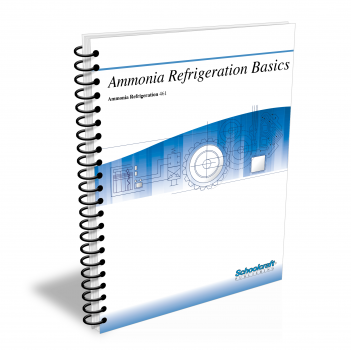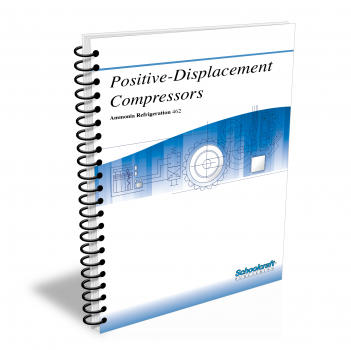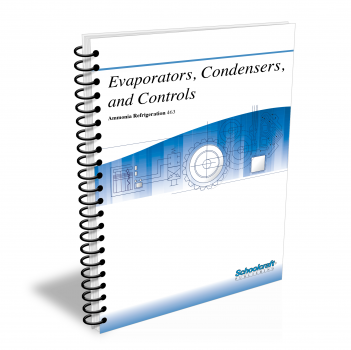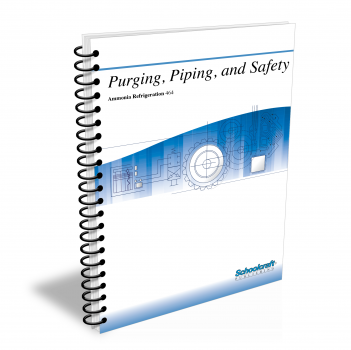Ammonia Refrigeration Basics

Course Number: 461
The Ammonia Refrigeration Basics textbook covers all aspects of using ammonia as a refrigerant. It describes both single-stage and two-stage ammonia systems, and explains the importance of accumulators and inter coolers in ammonia refrigeration. The textbook concludes with coverage of liquid recirculation system operation.
Does your curriculum require additional topics not included in this textbook? Build a customized version of the Ammonia Refrigeration Basics textbook below.
Recommended Contact Hours – 10
Preview a Chapter
Available Supporting Material
- Table of Contents
- Exam Copies
- Suggested Titles
Table of Contents
Chapter 1: Ammonia Characteristics
Topics: Ammonia sources, uses, and chemical characteristics; Environmental, hazardous material concerns; Temperature-pressure relationships; Materials compatibility; MSDS criteria; Safety
Learning Objectives:
- Name common uses of ammonia and describe benefits of ammonia refrigerant in terms of ozone depletion and global warming potentials (ODP and GWP).
- Describe the properties of ammonia and explain how they affect the use of ammonia as a refrigerant.
- Discuss the toxicity and flammability of ammonia and its classification as a hazardous material.
- Discuss important features of ammonia saturation curves, reactions with metals, and MSDS criteria.
- Name two standards governing ammonia refrigeration systems and describe the four main ammonia safety concerns, steps for their prevention, and first aid treatment in the event of exposure.
Chapter 2: Single-Stage Ammonia Systems
Topics: Positive-displacement systems; Refrigeration loads; Primary, secondary refrigeration system components; Components in parallel; Superheat; Single-stage pressure-enthalpy diagram
Learning Objectives:
- Briefly compare absorption and mechanical compression systems, compare dynamic and positive-displacement compressors, and name those generally used in industrial ammonia refrigeration systems.
- Explain how a positive-displacement compressor increases the ammonia vapor pressure.
- Define British thermal unit (Btu), specific heat, sensible heat, latent heat, and tons of refrigeration.
- Name four primary components in single-stage ammonia refrigeration systems and describe their functions.
- Describe the functions of the oil separator, high-pressure liquid receiver, king valve, and suction accumulator in single-stage ammonia refrigeration systems.
- Define superheat, enthalpy, and entropy and explain how they are used on the pressure-enthalpy (P-H) diagram.
Chapter 3: Two-Stage Ammonia Systems
Topics: Compression ratio; Compressor capacity; Two-stage system division, Booster desuperheater, intercooler; Two-stage system components, performance; Complex two-stage systems
Learning Objectives:
- Define compression ratio and explain its importance in single-stage and two-stage industrial ammonia refrigeration systems.
- Explain why flash gas removal, booster discharge-vapor desuperheating, and interstage liquid cooling are desirable in the two-stage system.
- Plot a two-stage refrigeration system on an ammonia pressure-enthalpy (P-H) diagram.
- Name the primary and secondary components of a two-stage refrigeration system and describe component functions.
- Explain why a two-stage system requires less overall power than a single-stage system.
Chapter 4: Suction Accumulators and Intercoolers
Topics: Need for suction accumulators; Accumulator design features; Liquid/vapor separation; Intercoolers; Shell-and-coil vs flash intercoolers; Alternate intercoolers
Learning Objectives:
- Explain why suction accumulators are needed and describe the damage that can result from liquid entering the compressor.
- Discuss the purposes and reasoning behind the design features, including the boil-out coil, of suction accumulators.
- Describe the various ammonia refrigerant liquid/vapor separation criteria.
- Explain how the intercooler deals with flash gas and desuperheats the booster discharge.
- Describe basic differences between a flash intercooler and a shell-and-coil intercooler.
- Describe typical configurations for alternate intercoolers provided with internally compounded compressors.
Chapter 5: Liquid Overfeed (Recirculation) Systems
Topics: Liquid overfeed, recirculation systems; Recirculation system advantages and disadvantages; Recirculation vessel design; Pumper drum system; Controlled pressure receiver system
Learning Objectives:
- Describe the various functions performed within the recirculation vessel.
- Discuss the advantages and disadvantages of recirculation systems.
- Describe design features of horizontal and vertical recirculation vessels.
- Discuss the surge-volume requirements of a recirculation system and reasons for high-level alarm/cutout controls on the recirculation vessel.
- Describe the features and drawbacks of various kinds of liquid-refrigerant pumps.
- Describe the operation of pumper drum (gas-pressure) recirculation systems and controlled pressure receiver (CPR) recirculation systems.
Request Exam Copies
Exam Copies
Ready to see a copy of our textbooks? After selecting which textbooks you’d like to review for your course, you can submit your request by either logging in or creating an account so we know where to ship your exam copies. A representative from Schoolcraft will contact you to confirm and finish processing your request.
Exam copies are always free and yours to keep.
Selected Exam Copies
none selected
* Maximum of five copies can be ordered


